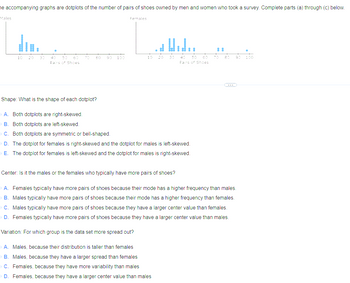
Holt Mcdougal Larson Pre-algebra: Student Edition 2012
1st Edition
ISBN: 9780547587776
Author: HOLT MCDOUGAL
Publisher: HOLT MCDOUGAL
expand_more
expand_more
format_list_bulleted
Question

Transcribed Image Text:he accompanying graphs are dotplots of the number of pairs of shoes owned by men and women who took a survey. Complete parts (a) through (c) below.
Males
10
8
0
Pairs of Shoes
70 20
Shape: What is the shape of each dotplot?
100
Females
10 20 30 40 50 60
Pairs of Shoes
A. Both dotplots are right-skewed.
B. Both dotplots are left-skewed.
C. Both dotplots are symmetric or bell-shaped.
D. The dotplot for females is right-skewed and the dotplot for males is left-skewed.
E. The dotplot for females is left-skewed and the dotplot for males is right-skewed.
Center: Is it the males or the females who typically have more pairs of shoes?
90 90
A. Females typically have more pairs of shoes because their mode has a higher frequency than males.
B. Males typically have more pairs of shoes because their mode has a higher frequency than females.
C. Males typically have more pairs of shoes because they have a larger center value than females.
D. Females typically have more pairs of shoes because they have a larger center value than males.
Variation: For which group is the data set more spread out?
A. Males, because their distribution is taller than females
B. Males, because they have a larger spread than females
C. Females, because they have more variability than males
D. Females, because they have a larger center value than males
Expert Solution
This question has been solved!
Explore an expertly crafted, step-by-step solution for a thorough understanding of key concepts.
This is a popular solution
Trending nowThis is a popular solution!
Step by stepSolved in 2 steps

Knowledge Booster
Similar questions
- Find the slpoe of the line: y=7arrow_forwardSo I'll include a line graph for a second visual aid. I have a chart to show the proportion of students by major that have student loan debt at our school.arrow_forwardA nurse recorded the pain level of a sample of patients being treated for the same illness. Pain levels were recorded using one of the following: no pain, minor pain, moderate pain, severe pain. Which type(s) of graph(s) and/or table(s) can be used to display the nurse's results? [Select all that apply (i.e. you may select 1 or more answers)] OA. Bar chart OB. Dotplot OC. Boxplot OD. Histogram OE. Frequency distributionarrow_forward
- Which graph has a line that represents the best fit for the recorded data?arrow_forwardCreate a line graph of the data using Excel. For how many of the years was the deficit greater than or equal to $320 million?arrow_forwardThe following scatterplot shows the relationship between a house's area (in square feet) and its acreage, or the area of its lot. Explain the trend in context of the graph. Scatterplot of Acreage vs Area 500 1000 1500 2000 2500 3000 3500 Area (in square feet) . ALTIENIC10 (Mac) Acreagearrow_forward
- What type of graphs( such as bar, histogram, etc) would be best to use to depict the relationship between the following variables? Please state the reason why the chosen graph was selected. how the number of days in theICU(intensive care unit) differ by renal failure status. the association between the number of days in the ICU and the number of hours in the operating room. the association between the number of days in the ICU and the number of hours on the bypass pump? the association between the number of hours in the operating room and the number of hours on a bypass pump? the relationship between the number of days in the ICU and gender?arrow_forwardSelect the graph that shows the scatterplot of the data set. O A. Q Y 2 - 1 -6 в. -7 -2 -5 1 с. D.arrow_forwardHelp.explain.arrow_forward
- Pls help ASAParrow_forwardper bag. The scatter plot below shows the relationship between the number of bags of popcorn that are sold and the price Number Sold Price Which of these graphs shows the line of best fit? A. A POPCORN SALES Number Sold C. C y Number Sold y POPCORN SALES Price POPCORN SALES Price x B. (B) D. D Number Sold Number Sold y POPCORN SALES Price POPCORN SALES Pricearrow_forward
arrow_back_ios
arrow_forward_ios
Recommended textbooks for you
 Holt Mcdougal Larson Pre-algebra: Student Edition...AlgebraISBN:9780547587776Author:HOLT MCDOUGALPublisher:HOLT MCDOUGAL
Holt Mcdougal Larson Pre-algebra: Student Edition...AlgebraISBN:9780547587776Author:HOLT MCDOUGALPublisher:HOLT MCDOUGAL Glencoe Algebra 1, Student Edition, 9780079039897...AlgebraISBN:9780079039897Author:CarterPublisher:McGraw HillAlgebra & Trigonometry with Analytic GeometryAlgebraISBN:9781133382119Author:SwokowskiPublisher:Cengage
Glencoe Algebra 1, Student Edition, 9780079039897...AlgebraISBN:9780079039897Author:CarterPublisher:McGraw HillAlgebra & Trigonometry with Analytic GeometryAlgebraISBN:9781133382119Author:SwokowskiPublisher:Cengage Big Ideas Math A Bridge To Success Algebra 1: Stu...AlgebraISBN:9781680331141Author:HOUGHTON MIFFLIN HARCOURTPublisher:Houghton Mifflin Harcourt
Big Ideas Math A Bridge To Success Algebra 1: Stu...AlgebraISBN:9781680331141Author:HOUGHTON MIFFLIN HARCOURTPublisher:Houghton Mifflin Harcourt College Algebra (MindTap Course List)AlgebraISBN:9781305652231Author:R. David Gustafson, Jeff HughesPublisher:Cengage Learning
College Algebra (MindTap Course List)AlgebraISBN:9781305652231Author:R. David Gustafson, Jeff HughesPublisher:Cengage Learning

Holt Mcdougal Larson Pre-algebra: Student Edition...
Algebra
ISBN:9780547587776
Author:HOLT MCDOUGAL
Publisher:HOLT MCDOUGAL

Glencoe Algebra 1, Student Edition, 9780079039897...
Algebra
ISBN:9780079039897
Author:Carter
Publisher:McGraw Hill

Algebra & Trigonometry with Analytic Geometry
Algebra
ISBN:9781133382119
Author:Swokowski
Publisher:Cengage

Big Ideas Math A Bridge To Success Algebra 1: Stu...
Algebra
ISBN:9781680331141
Author:HOUGHTON MIFFLIN HARCOURT
Publisher:Houghton Mifflin Harcourt

College Algebra (MindTap Course List)
Algebra
ISBN:9781305652231
Author:R. David Gustafson, Jeff Hughes
Publisher:Cengage Learning
